Mei Li
additional authors not shown
Qwen3 Technical Report
May 14, 2025Abstract:In this work, we present Qwen3, the latest version of the Qwen model family. Qwen3 comprises a series of large language models (LLMs) designed to advance performance, efficiency, and multilingual capabilities. The Qwen3 series includes models of both dense and Mixture-of-Expert (MoE) architectures, with parameter scales ranging from 0.6 to 235 billion. A key innovation in Qwen3 is the integration of thinking mode (for complex, multi-step reasoning) and non-thinking mode (for rapid, context-driven responses) into a unified framework. This eliminates the need to switch between different models--such as chat-optimized models (e.g., GPT-4o) and dedicated reasoning models (e.g., QwQ-32B)--and enables dynamic mode switching based on user queries or chat templates. Meanwhile, Qwen3 introduces a thinking budget mechanism, allowing users to allocate computational resources adaptively during inference, thereby balancing latency and performance based on task complexity. Moreover, by leveraging the knowledge from the flagship models, we significantly reduce the computational resources required to build smaller-scale models, while ensuring their highly competitive performance. Empirical evaluations demonstrate that Qwen3 achieves state-of-the-art results across diverse benchmarks, including tasks in code generation, mathematical reasoning, agent tasks, etc., competitive against larger MoE models and proprietary models. Compared to its predecessor Qwen2.5, Qwen3 expands multilingual support from 29 to 119 languages and dialects, enhancing global accessibility through improved cross-lingual understanding and generation capabilities. To facilitate reproducibility and community-driven research and development, all Qwen3 models are publicly accessible under Apache 2.0.
BECAME: BayEsian Continual Learning with Adaptive Model MErging
Apr 03, 2025Abstract:Continual Learning (CL) strives to learn incrementally across tasks while mitigating catastrophic forgetting. A key challenge in CL is balancing stability (retaining prior knowledge) and plasticity (learning new tasks). While representative gradient projection methods ensure stability, they often limit plasticity. Model merging techniques offer promising solutions, but prior methods typically rely on empirical assumptions and carefully selected hyperparameters. In this paper, we explore the potential of model merging to enhance the stability-plasticity trade-off, providing theoretical insights that underscore its benefits. Specifically, we reformulate the merging mechanism using Bayesian continual learning principles and derive a closed-form solution for the optimal merging coefficient that adapts to the diverse characteristics of tasks. To validate our approach, we introduce a two-stage framework named BECAME, which synergizes the expertise of gradient projection and adaptive merging. Extensive experiments show that our approach outperforms state-of-the-art CL methods and existing merging strategies.
Machine Learning-Based Genomic Linguistic Analysis (Gene Sequence Feature Learning): A Case Study on Predicting Heavy Metal Response Genes in Rice
Mar 20, 2025Abstract:This study explores the application of machine learning-based genetic linguistics for identifying heavy metal response genes in rice (Oryza sativa). By integrating convolutional neural networks and random forest algorithms, we developed a hybrid model capable of extracting and learning meaningful features from gene sequences, such as k-mer frequencies and physicochemical properties. The model was trained and tested on datasets of genes, achieving high predictive performance (precision: 0.89, F1-score: 0.82). RNA-seq and qRT-PCR experiments conducted on rice leaves which exposed to Hg0, revealed differential expression of genes associated with heavy metal responses, which validated the model's predictions. Co-expression network analysis identified 103 related genes, and a literature review indicated that these genes are highly likely to be involved in heavy metal-related biological processes. By integrating and comparing the analysis results with those of differentially expressed genes (DEGs), the validity of the new machine learning method was further demonstrated. This study highlights the efficacy of combining machine learning with genetic linguistics for large-scale gene prediction. It demonstrates a cost-effective and efficient approach for uncovering molecular mechanisms underlying heavy metal responses, with potential applications in developing stress-tolerant crop varieties.
Qwen2.5-1M Technical Report
Jan 26, 2025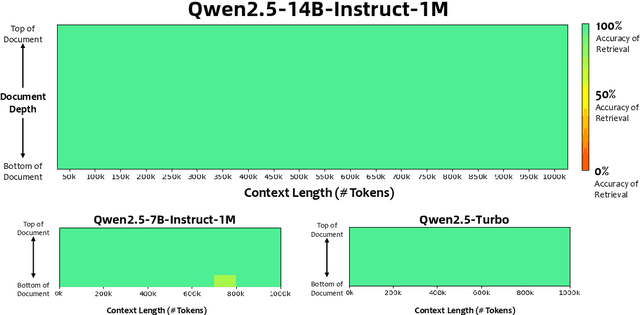


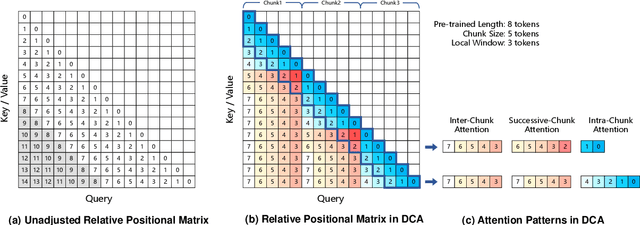
Abstract:We introduce Qwen2.5-1M, a series of models that extend the context length to 1 million tokens. Compared to the previous 128K version, the Qwen2.5-1M series have significantly enhanced long-context capabilities through long-context pre-training and post-training. Key techniques such as long data synthesis, progressive pre-training, and multi-stage supervised fine-tuning are employed to effectively enhance long-context performance while reducing training costs. To promote the use of long-context models among a broader user base, we present and open-source our inference framework. This framework includes a length extrapolation method that can expand the model context lengths by at least four times, or even more, without additional training. To reduce inference costs, we implement a sparse attention method along with chunked prefill optimization for deployment scenarios and a sparsity refinement method to improve precision. Additionally, we detail our optimizations in the inference engine, including kernel optimization, pipeline parallelism, and scheduling optimization, which significantly enhance overall inference performance. By leveraging our inference framework, the Qwen2.5-1M models achieve a remarkable 3x to 7x prefill speedup in scenarios with 1 million tokens of context. This framework provides an efficient and powerful solution for developing applications that require long-context processing using open-source models. The Qwen2.5-1M series currently includes the open-source models Qwen2.5-7B-Instruct-1M and Qwen2.5-14B-Instruct-1M, as well as the API-accessed model Qwen2.5-Turbo. Evaluations show that Qwen2.5-1M models have been greatly improved in long-context tasks without compromising performance in short-context scenarios. Specifically, the Qwen2.5-14B-Instruct-1M model significantly outperforms GPT-4o-mini in long-context tasks and supports contexts eight times longer.
Qwen2.5 Technical Report
Dec 19, 2024

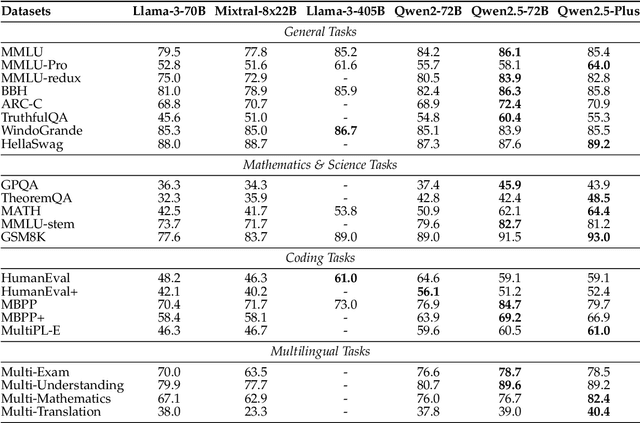
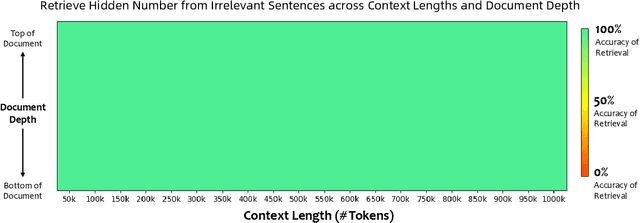
Abstract:In this report, we introduce Qwen2.5, a comprehensive series of large language models (LLMs) designed to meet diverse needs. Compared to previous iterations, Qwen 2.5 has been significantly improved during both the pre-training and post-training stages. In terms of pre-training, we have scaled the high-quality pre-training datasets from the previous 7 trillion tokens to 18 trillion tokens. This provides a strong foundation for common sense, expert knowledge, and reasoning capabilities. In terms of post-training, we implement intricate supervised finetuning with over 1 million samples, as well as multistage reinforcement learning. Post-training techniques enhance human preference, and notably improve long text generation, structural data analysis, and instruction following. To handle diverse and varied use cases effectively, we present Qwen2.5 LLM series in rich sizes. Open-weight offerings include base and instruction-tuned models, with quantized versions available. In addition, for hosted solutions, the proprietary models currently include two mixture-of-experts (MoE) variants: Qwen2.5-Turbo and Qwen2.5-Plus, both available from Alibaba Cloud Model Studio. Qwen2.5 has demonstrated top-tier performance on a wide range of benchmarks evaluating language understanding, reasoning, mathematics, coding, human preference alignment, etc. Specifically, the open-weight flagship Qwen2.5-72B-Instruct outperforms a number of open and proprietary models and demonstrates competitive performance to the state-of-the-art open-weight model, Llama-3-405B-Instruct, which is around 5 times larger. Qwen2.5-Turbo and Qwen2.5-Plus offer superior cost-effectiveness while performing competitively against GPT-4o-mini and GPT-4o respectively. Additionally, as the foundation, Qwen2.5 models have been instrumental in training specialized models such as Qwen2.5-Math, Qwen2.5-Coder, QwQ, and multimodal models.
KAAE: Numerical Reasoning for Knowledge Graphs via Knowledge-aware Attributes Learning
Nov 20, 2024Abstract:Numerical reasoning is pivotal in various artificial intelligence applications, such as natural language processing and recommender systems, where it involves using entities, relations, and attribute values (e.g., weight, length) to infer new factual relations (e.g., the Nile is longer than the Amazon). However, existing approaches encounter two critical challenges in modeling: (1) semantic relevance-the challenge of insufficiently capturing the necessary contextual interactions among entities, relations, and numerical attributes, often resulting in suboptimal inference; and (2) semantic ambiguity-the difficulty in accurately distinguishing ordinal relationships during numerical reasoning, which compromises the generation of high-quality samples and limits the effectiveness of contrastive learning. To address these challenges, we propose the novel Knowledge-Aware Attributes Embedding model (KAAE) for knowledge graph embeddings in numerical reasoning. Specifically, to overcome the challenge of semantic relevance, we introduce a Mixture-of-Experts-Knowledge-Aware (MoEKA) Encoder, designed to integrate the semantics of entities, relations, and numerical attributes into a joint semantic space. To tackle semantic ambiguity, we implement a new ordinal knowledge contrastive learning (OKCL) strategy that generates high-quality ordinal samples from the original data with the aid of ordinal relations, capturing fine-grained semantic nuances essential for accurate numerical reasoning. Experiments on three public benchmark datasets demonstrate the superior performance of KAAE across various attribute value distributions.
NT-LLM: A Novel Node Tokenizer for Integrating Graph Structure into Large Language Models
Oct 14, 2024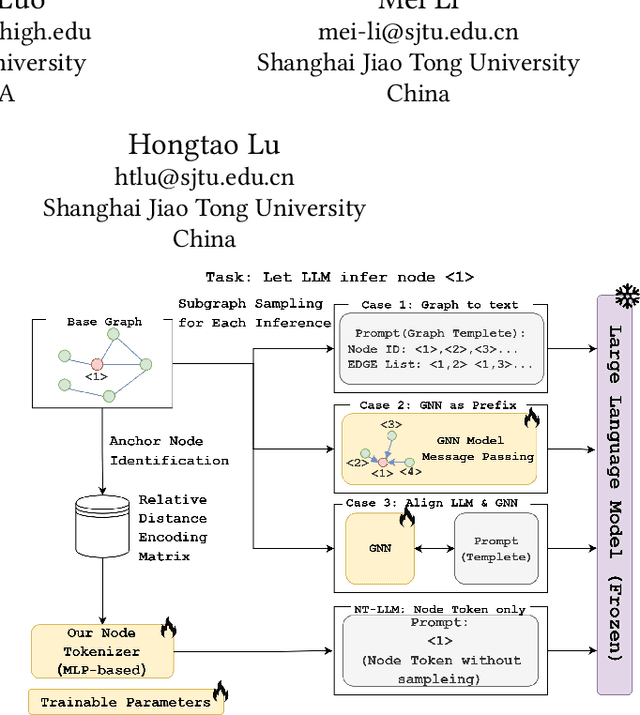

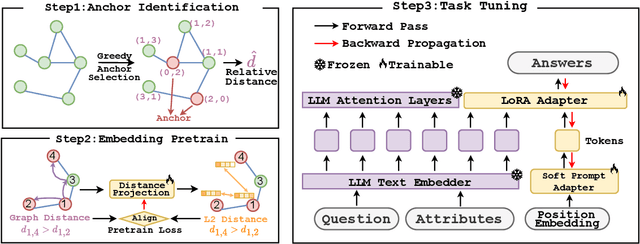

Abstract:Graphs are a fundamental data structure for representing relationships in real-world scenarios. With the success of Large Language Models (LLMs) across various natural language processing (NLP) tasks, there has been growing interest in integrating LLMs for graph learning. However, applying LLMs to graph-related tasks poses significant challenges, as these models are not inherently designed to capture the complex structural information present in graphs. Existing approaches address this challenge through two strategies: the chain of tasks approach, which uses Graph Neural Networks (GNNs) to encode the graph structure so that LLMs are relieved from understanding spatial positions; and Graph-to-Text Conversion, which translates graph structures into semantic text representations that LLMs can process. Despite their progress, these methods often struggle to fully preserve the topological information of graphs or require extensive computational resources, limiting their practical applicability. In this work, we introduce Node Tokenizer for Large Language Models (NT-LLM), a novel framework that efficiently encodes graph structures by selecting key nodes as anchors and representing each node based on its relative distance to these anchors. This position-anchored encoding effectively captures the graph topology, enabling enhanced reasoning capabilities in LLMs over graph data. Additionally, we implement a task-specific tuning procedure to further improve structural understanding within LLMs. Through extensive empirical evaluations, NT-LLM demonstrates significant performance improvements across a variety of graph-related tasks.
SciSafeEval: A Comprehensive Benchmark for Safety Alignment of Large Language Models in Scientific Tasks
Oct 02, 2024



Abstract:Large language models (LLMs) have had a transformative impact on a variety of scientific tasks across disciplines such as biology, chemistry, medicine, and physics. However, ensuring the safety alignment of these models in scientific research remains an underexplored area, with existing benchmarks primarily focus on textual content and overlooking key scientific representations such as molecular, protein, and genomic languages. Moreover, the safety mechanisms of LLMs in scientific tasks are insufficiently studied. To address these limitations, we introduce SciSafeEval, a comprehensive benchmark designed to evaluate the safety alignment of LLMs across a range of scientific tasks. SciSafeEval spans multiple scientific languages - including textual, molecular, protein, and genomic - and covers a wide range of scientific domains. We evaluate LLMs in zero-shot, few-shot and chain-of-thought settings, and introduce a 'jailbreak' enhancement feature that challenges LLMs equipped with safety guardrails, rigorously testing their defenses against malicious intention. Our benchmark surpasses existing safety datasets in both scale and scope, providing a robust platform for assessing the safety and performance of LLMs in scientific contexts. This work aims to facilitate the responsible development and deployment of LLMs, promoting alignment with safety and ethical standards in scientific research.
Qwen2 Technical Report
Jul 16, 2024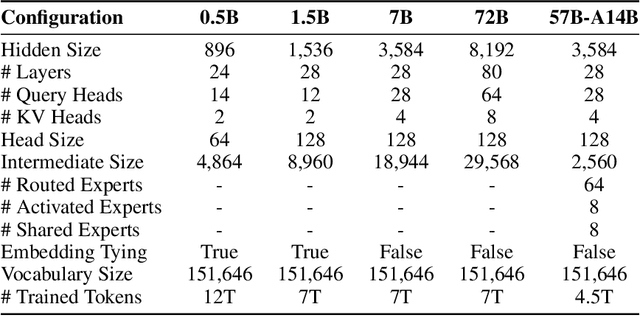
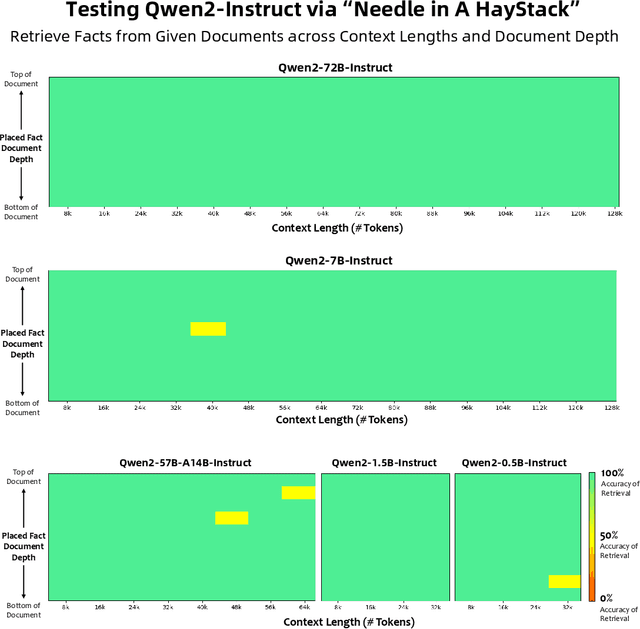
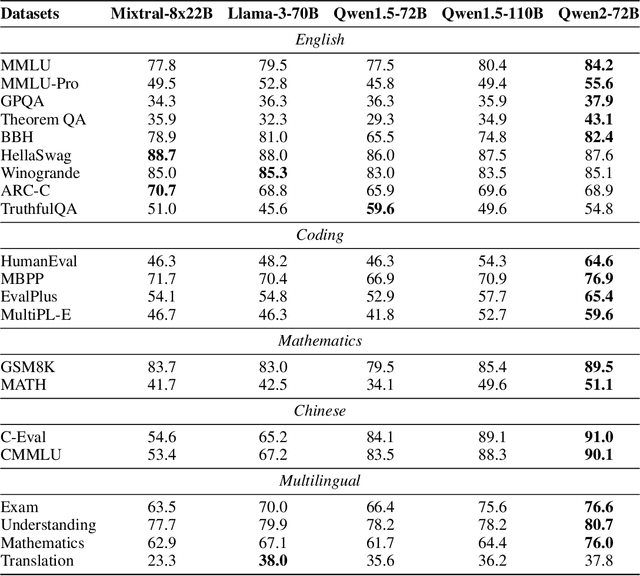
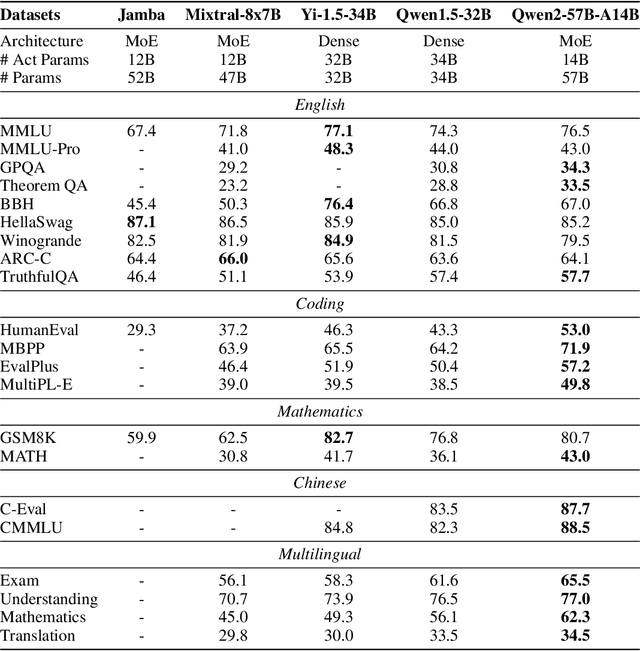
Abstract:This report introduces the Qwen2 series, the latest addition to our large language models and large multimodal models. We release a comprehensive suite of foundational and instruction-tuned language models, encompassing a parameter range from 0.5 to 72 billion, featuring dense models and a Mixture-of-Experts model. Qwen2 surpasses most prior open-weight models, including its predecessor Qwen1.5, and exhibits competitive performance relative to proprietary models across diverse benchmarks on language understanding, generation, multilingual proficiency, coding, mathematics, and reasoning. The flagship model, Qwen2-72B, showcases remarkable performance: 84.2 on MMLU, 37.9 on GPQA, 64.6 on HumanEval, 89.5 on GSM8K, and 82.4 on BBH as a base language model. The instruction-tuned variant, Qwen2-72B-Instruct, attains 9.1 on MT-Bench, 48.1 on Arena-Hard, and 35.7 on LiveCodeBench. Moreover, Qwen2 demonstrates robust multilingual capabilities, proficient in approximately 30 languages, spanning English, Chinese, Spanish, French, German, Arabic, Russian, Korean, Japanese, Thai, Vietnamese, and more, underscoring its versatility and global reach. To foster community innovation and accessibility, we have made the Qwen2 model weights openly available on Hugging Face and ModelScope, and the supplementary materials including example code on GitHub. These platforms also include resources for quantization, fine-tuning, and deployment, facilitating a wide range of applications and research endeavors.
Qwen Technical Report
Sep 28, 2023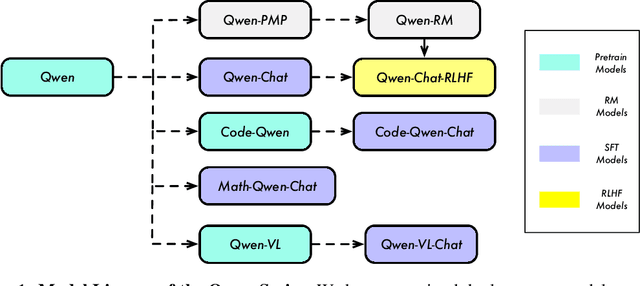

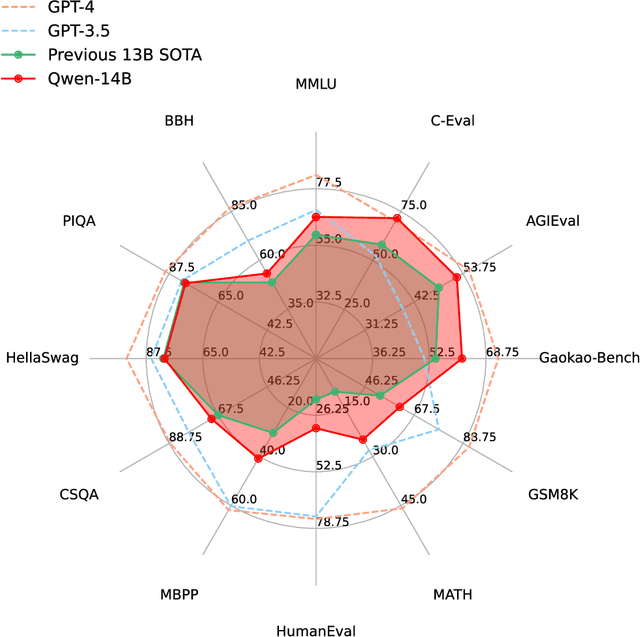
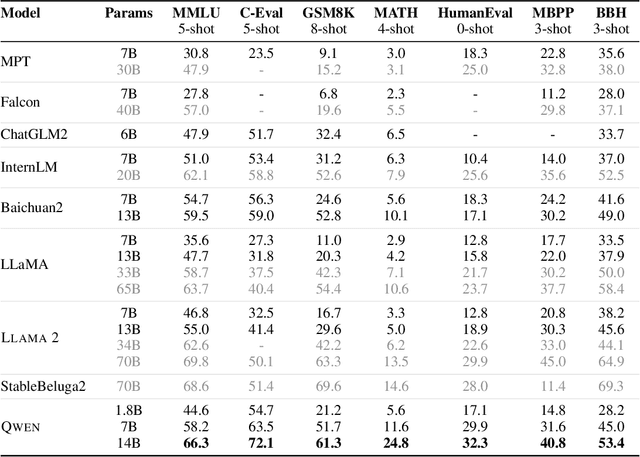
Abstract:Large language models (LLMs) have revolutionized the field of artificial intelligence, enabling natural language processing tasks that were previously thought to be exclusive to humans. In this work, we introduce Qwen, the first installment of our large language model series. Qwen is a comprehensive language model series that encompasses distinct models with varying parameter counts. It includes Qwen, the base pretrained language models, and Qwen-Chat, the chat models finetuned with human alignment techniques. The base language models consistently demonstrate superior performance across a multitude of downstream tasks, and the chat models, particularly those trained using Reinforcement Learning from Human Feedback (RLHF), are highly competitive. The chat models possess advanced tool-use and planning capabilities for creating agent applications, showcasing impressive performance even when compared to bigger models on complex tasks like utilizing a code interpreter. Furthermore, we have developed coding-specialized models, Code-Qwen and Code-Qwen-Chat, as well as mathematics-focused models, Math-Qwen-Chat, which are built upon base language models. These models demonstrate significantly improved performance in comparison with open-source models, and slightly fall behind the proprietary models.
 Add to Chrome
Add to Chrome Add to Firefox
Add to Firefox Add to Edge
Add to Edge